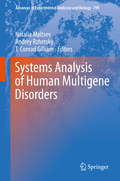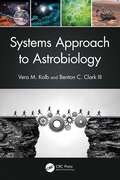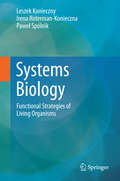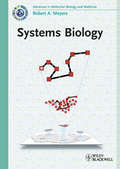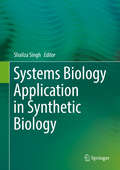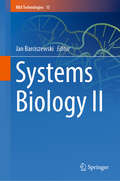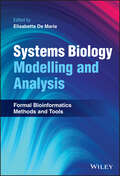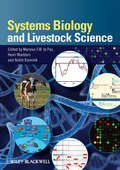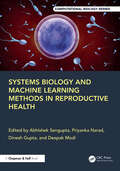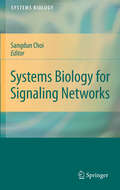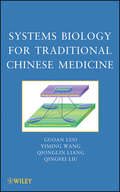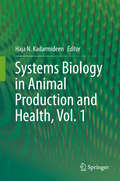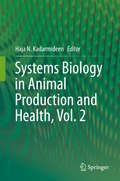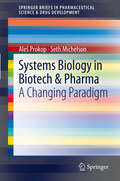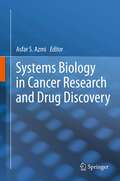- Table View
- List View
Systems Analysis and Design in a Changing World
by Robert B. Jackson John W. Satzinger Stephen D. BurdReflecting the latest practices, trends, and developments from the field, SYSTEMS ANALYSIS AND DESIGN IN A CHANGING WORLD, 7E equips you with a solid foundation of the most important principles of systems analysis, systems design, project management, and new software development approaches. Using case driven techniques, the succinct 14-chapter book focuses on content that is key to your success in today's market. The book teaches both traditional (structured) and object-oriented (OO) approaches to systems analysis and design. It highlights use cases, use diagrams, and use case descriptions required for a modeling approach, while demonstrating their application to traditional, web development, object-oriented, and service-oriented architecture approaches. Content reflects Microsoft Project 2013 Professional and Microsoft Visio 2013.
Systems Analysis of Chromatin-Related Protein Complexes in Cancer
by Andrew Emili Shoshana Wodak Jack GreenblattEpigenetic modifications underlie all aspects of human physiology, including stem cell renewal, formation of cell types and tissues. They also underlie environmental impacts on human health, including aging and diseases like cancer. Consequently, cracking the epigenetic "code" is considered a key challenge in biomedical research. Chromatin structure and function are modified by protein complexes, causing genes to be turned "on" or "off" and controlling other aspects of DNA function. Yet while there has been explosive growth in the epigenetics field, human chromatin-modifying machines have only recently started to be characterized. To meet this challenge, our book explores complementary experimental tracks, pursued by expert international research groups, aimed at the physical and functional characterization of the diverse repertoire of chromatin protein machines - namely, the "readers, writers and erasers" of epigenomic marks. These studies include the identification of RNA molecules and drugs that interact selectively with components of the chromatin machinery. What makes this book distinctive is its emphasis on the systematic exploration of chromatin protein complexes in the context of human development and disease networks.
Systems Analysis of Human Multigene Disorders
by Natalia Maltsev Andrey Rzhetsky T. Conrad GilliamUnderstanding the genetic architecture underlying complex multigene disorders is one of the major goals of human genetics in the upcoming decades. Advances in whole genome sequencing and the success of high throughput functional genomics allow supplementing conventional reductionist biology with systems-level approaches to human heredity and health as systems of interacting genetic, epigenetic, and environmental factors. This integrative approach holds the promise of unveiling yet unexplored levels of molecular organization and biological complexity. It may also hold the key to deciphering the multigene patterns of disease inheritance.
Systems Approach to Astrobiology
by Vera M. Kolb Benton C. ClarkSystems thinking/analysis is widely applied for solving complex problems in engineering and certain other fields. Astrobiology, which inherently involves complex problems, can benefit from such an approach.
Systems Approaches to Nuclear Fusion Reactors (Springer Series in Plasma Science and Technology)
by Frederick B. MarcusThis book offers an overall review, applying systems engineering and architecture approaches, of the design, optimization, operation and results of leading fusion experiments. These approaches provide a unified means of evaluating reactor design. Methodologies are developed for more coherent construction or evaluation of fusion devices, associated experiments and operating procedures. The main focus is on tokamaks, with almost all machines and their important results being integrated into a systems design space. Case studies focus on DIII-D, TCV, JET, WEST, the fusion reactor prototype ITER and the EU DEMO concept. Stellarator, Mirror and Laser inertial confinement experiments are similarly analysed, including reactor implications of breakeven at NIF.The book examines the engineering and physics design and optimization process for each machine, analysing their performance and major results achieved, thus establishing a basis for the improvement of future machines. The reader will gain a broad historical and up-to-date perspective of the status of nuclear fusion research from both an engineering and physics point of view. Explanations are given of the computational tools needed to design and operate successful experiments and reactor-relevant machines. This book is aimed at both graduate students and practitioners of nuclear fusion science and engineering, as well as those specializing in other fields demanding large and integrated experimental equipment. Systems engineers will obtain valuable insights into fusion applications. References are given to associated complex mathematical derivations, which are beyond the scope of this book. The general reader interested in nuclear fusion will find here an accessible summary of the current state of nuclear fusion.
Systems Biology
by Bernhard Ø. PalssonGenome sequences are now available that enable us to determine the biological components that make up a cell or an organism. The discipline of systems biology examines how these components interact and form networks, and how the networks generate whole cell functions corresponding to observable phenotypes. This 2006 textbook devoted to systems biology describes how to model networks, how to determine their properties, and how to relate these to phenotypic functions. The prerequisites are some knowledge of linear algebra and biochemistry. Though the links between the mathematical ideas and biological processes are made clear, the book reflects the irreversible trend of increasing mathematical content in biology education. Therefore to assist both teacher and student, in an associated web site Palsson provides problem sets, projects and Powerpoint slides, and keeps the presentation in the book concrete with illustrative material and experimental results.
Systems Biology
by Irena Roterman-Konieczna Leszek Konieczny Paweł SpólnikThe objective of this book is to present the strategies employed by living organisms on a molecular level and to help understand the basics of Systems Biology. Its content is organized in a way to meet the exponential growth in the volume of biological knowledge, and the need for a multidisciplinary approach in the practice of teaching modern biology. For this reason, the whole material is divided into five chapters, each devoted to a fundamental concept: Structure-Function, Energy, Information, Regulation and Interrelationships. The book describes generic mechanisms which occur in biology and promotes a simulation-based approach to the subject of Systems Biology. The use of basic knowledge as the background for presenting biological problems obligates the teachers to deal with generalized phenomena comprising the ever increasing volume of teaching materials. This book is intended for biologists and is informative for specialists in the areas of computer science, robotics and engineering.
Systems Biology
by Ivan V. MalyThe rapidly developing methods of systems biology can help investigators to make inference and predictions from their data that intuition alone would not discern; however, the difficulty lies in the broad knowledge of mathematics and engineering that seems to be required to even evaluate the applicability of the methods to the problem at hand. In "Systems Biology", scientists who possess that mathematical knowledge and have applied it effectively to various biological problems contribute methods which reflect their experience, crystallized in a form very similar to typical biological laboratory protocols. In order to best aid researchers, the chapters supply the theory behind the method, its step-by-step implementation, and the pitfalls explained thoroughly and from the practical angle. As a volume of the highly successful Methods in Molecular BiologyTM series, this work provides the kind of detailed description and implementation advice that is crucial for getting optimal results. Cutting-edge and easy to use, "Systems Biology" shatters the perceived insurmountable barrier between the laboratory and systems-biological research techniques.
Systems Biology
by Robert A. MeyersSystems biology is a relatively new biological study field that focuses on the systematic study of complex interactions in biological systems, thus using a new perspective (integration instead of reduction) to study them. Particularly from year 2000 onwards, the term is used widely in the biosciences, and in a variety of contexts. Systems biology is the study of the interconnected aspect of molecular, cellular, tissue, whole animal and ecological processes, and comprises mathematical and mechanistic studies of dynamical, mesoscopic, open, spatiotemporally defined, nonlinear, complex systems that are far from thermodynamic equilibrium.Containing a unique selection of new and updated, high-quality articles from the well-known Meyer's Encyclopedia of Molecular Cell Biology and Molecular Medicine, this two-volume handbook is an essential guide for students and researchers wishing to get an overview of the field.
Systems Biology (Methods in Molecular Biology #2745)
by Mariano BizzarriThis second edition volume expands on the previous edition with discussions of the latest advancements and methods used by scientists to study systems biology. The chapters in this book are organized into four parts. Part One looks at models in systems biology and parameters identification such as short peptide analysis, metastasis models, and metabolomics. Part Two covers computational methods in the study of organisms, and cancer non-linear dynamics. Part Three discusses critical transition states across Waddington’s like landscapes such as understanding cell differentiation through single-cell approaches and modeling mammary organogenesis from biological first principles. Part Four talks about specific fields of investigation including inborn errors of metabolism, system biology approach in epithelial-mesenchymal transition, and an approach to understanding how COVID-19 spreads in the population. Written in the highly successful Methods in Molecular Biology series format, chapters include introductions to their respective topics, lists of the necessary materials and reagents, step-by-step, readily reproducible laboratory protocols, and tips on troubleshooting and avoiding known pitfalls.Cutting-edge and comprehensive, Systems Biology, Second Edition is a valuable tool for any researcher looking to learn more about this important and developing field.
Systems Biology (Rna Technologies Ser.)
by Jan Barciszewski Stefan Jurga Nikolaus RajewskyMany breakthroughs in experimental devices, advanced software, as well as analytical methods for systems biology development have helped shape the way we study DNA, RNA and proteins, on the genomic, transcriptional, translational and posttranslational level. This book highlights the comprehensive topics that encompass systems biology with enormous progress in the development of genome sequencing, proteomic and metabolomic methods in designing and understanding biological systems.Topics covered in this book include fundamentals of modelling networks, circuits and pathways, spatial and multi cellular systems, image-driven systems biology, evolution, noise and decision-making in single cells, systems biology of disease and immunology, and personalized medicine. Special attention is paid to epigenomics, in particular environmental conditions that impact genetic background. The breadth of exciting new data towards discovering fundamental principles and direct application of epigenetics in agriculture is also described.The chapter “Deciphering the Universe of RNA Structures and Trans RNA-RNA Interactions of Transcriptomes in vivo - from Experimental Protocols to Computational Analyses” is available open access under a CC BY 4.0 license via link.springer.com.
Systems Biology Application in Synthetic Biology
by Shailza SinghThis book introduces students tomethods that will help them understand behaviour in terms of cellularcomponents and their interactions in non-intuitive ways, which calls for aninterdisciplinary approach combining mathematical, chemical, computational andbiological strategies. Tibor Ganti was one of the early pioneers whoproposed a theoretical framework to understand living principles in terms ofchemical transformation cycles and their coupling. The twenty-first centurythen brought with it a novel 'systems' paradigm, which shone new light on allprevious work and was accompanied by numerous implications for the way weconceive of chemical and biological complexity today. This book seeks to equip students totake advantage of any field that investigates living systems. Based on aconceptualisation of science-oriented branches, engineering-oriented branchesand biology as astoundingly complex fields, those structures laden withbiochemical detail encompass a deeper theory unifying our knowledge of designedsystems. Readers will be pleasantly surprised athow lucidly the topics are presented. The book offers an indispensable resourcefor students and professionals working in systems and synthetic biology or anyof the various related fields of research.
Systems Biology Approaches: Prevention, Diagnosis, and Understanding Mechanisms of Complex Diseases
by Sanket Joshi Rina Rani Ray Moupriya Nag Dibyajit LahiriThis book examines the development and applications of system biology approaches for the prevention, diagnosis, and understanding of disease mechanisms. It explores the applications of system biology in infectious diseases, including host-pathogen interaction, and the identification of targets for new therapeutics and intervention strategies. It covers the use of system biology for understanding and treating metabolic disorders towards personalized and precision medicine. The book further discusses the systems biology approaches for understanding the mechanisms of tumor progression and designing more effective cancer therapies. The chapter also reviews the current strategies in autoimmune disease treatment and highlights the opportunity that systems biology represents for the development of better and safer treatments. Importantly, the book discusses the current state of the systems-level understanding of diseases and both the therapeutic and adverse mechanisms of drug actions usingsystem biology approaches. Cutting across the disciplines, this book is a valuable source for researchers in genetics, molecular biology, cell biology, microbiology, and biomedical sciences.
Systems Biology II (RNA Technologies #15)
by Jan BarciszewskiModern biology is moving away from reductionist approaches towards holistic studies that encompass whole genomes, transcriptomes, proteomes, and metabolomes. Systems biology is an approach to studying complex biological systems by looking at many biomolecules in a comprehensive way. The aim is to gain a thorough understanding of the biological functions of different classes of molecules and their interactions. Systems Biology II is an up-to-date and comprehensive guide to the latest developments in systems biology, with a particular focus on RNA-based technologies. This book is the second volume in the RNA Technologies series dedicated to this topic. It presents cutting-edge approaches and tools for modelling and analyzing complex biological systems at different levels, from molecular interactions to cellular networks and beyond. With contributions from leading experts in the field, the book covers a wide range of topics, including gene regulatory networks, epigenetics, synthetic biology, omics data analysis, network inference, and more. It explores applications in various areas of the life sciences and biomedicine, such as vaccine development, cancer research, transplantation research and pathogenic processes. This volume is an essential resource for scientists and students working in systems biology, bioinformatics, synthetic biology, and related fields, as well as anyone interested in the latest advances in RNA technologies and their applications in biology and medicine.
Systems Biology Modelling and Analysis: Formal Bioinformatics Methods and Tools
by Elisabetta De MariaSystems Biology Modelling and Analysis Describes important modelling and computational methods for systems biology research to enable practitioners to select and use the most suitable technique Systems Biology Modelling and Analysis provides an overview of state-of-the-art techniques and introduces related tools and practices to formalize models and automate reasoning for systems biology. The authors present and compare the main formal methods used in systems biology for modelling biological networks, including discussion of their advantages, drawbacks, and main applications. Each chapter includes an intuitive presentation of the specific formalism, a brief history of the formalism and of its applications in systems biology, a formal description of the formalism and its variants, at least one realistic case study, some applications of formal techniques to validate and make deep analysis of models encoded with the formalism, and a discussion on the kind of biological systems for which the formalism is suited, along with concrete ideas on its possible evolution. Edited by a highly qualified expert with significant experience in the field, some of the methods and techniques covered in Systems Biology Modelling and Analysis include: Petri nets, an important tool for studying different aspects of biological systems, ranging from simple signaling pathways to metabolic networks and beyond Pathway Logic, a formal, rule-based system and interactive viewer for developing executable models of cellular processes Boolean networks, a mathematical model which has been widely used for decades in the context of biological regulation networks Answer Set Programming (ASP), which has proven to be a strong logic programming paradigm to deal with the inherent complexity of biological models For systems biologists, biochemists, bioinformaticians, molecular biologists, pharmacologists, and computer scientists, Systems Biology Modelling and Analysis is a comprehensive all-in-one resource to understand and harness the field’s current models and techniques while also preparing for their potential developments in coming years with the help of the author’s expert insight.
Systems Biology Volume 1: Integrative Biology and Simulation Tools
by Aleš Prokop Bela CsukasGrowth in the pharmaceutical market has slowed down - almost to a standstill. One reason is that governments and other payers are cutting costs in a faltering world economy. But a more fundamental problem is the failure of major companies to discover, develop and market new drugs. Major drugs losing patent protection or being withdrawn from the market are simply not being replaced by new therapies - the pharmaceutical market model is no longer functioning effectively and most pharmaceutical companies are failing to produce the innovation needed for success. This multi-authored new book looks at a vital strategy which can bring innovation to a market in need of new ideas and new products: Systems Biology (SB). Modeling is a significant task of systems biology. SB aims to develop and use efficient algorithms, data structures, visualization and communication tools to orchestrate the integration of large quantities of biological data with the goal of computer modeling. It involves the use of computer simulations of biological systems, such as the networks of metabolites comprise signal transduction pathways and gene regulatory networks to both analyze and visualize the complex connections of these cellular processes. SB involves a series of operational protocols used for performing research, namely a cycle composed of theoretical, analytic or computational modeling to propose specific testable hypotheses about a biological system, experimental validation, and then using the newly acquired quantitative description of cells or cell processes to refine the computational model or theory.
Systems Biology and Bioinformatics: A Computational Approach
by Kayvan Najarian Siamak Najarian Shahriar Gharibzadeh Christopher N. EichelbergerThe availability of molecular imaging and measurement systems enables today's biologists to swiftly monitor thousands of genes involved in a host of diseases, a critical factor in specialized drug development. Systems Biology and Bioinformatics: A Computational Approach provides students with a comprehensive collection of the computational methods
Systems Biology and Livestock Science
by Marinus F.W. te PasSystems Biology is an interdisciplinary approach to the study of life made possible through the explosion of molecular data made available through the genome revolution and the simultaneous development of computational technologies that allow us to interpret these large data sets. Systems Biology has changed the way biological science views and studies life and has been implemented in research efforts across the biological sciences. Systems Biology and Livestock Science will be the first book to review the latest advances using this research methodology in efforts to improve the efficiency, health, and quality of livestock production. Systems Biology and Livestock Science opens with useful introductory chapters explaining key systems biology principles. The chapters then progress to look at specific advances in fields across livestock science. Coverage includes, but is not limited to, chapters on systems biology approaches to animal nutrition, reproduction, health and disease, and animal physiology. Written by leading researchers in the field, Systems Biology and Livestock Science, will be an invaluable resource to researchers, professionals, and advance students working in this rapidly developing discipline.
Systems Biology and Machine Learning Methods in Reproductive Health (Chapman & Hall/CRC Computational Biology Series)
by Dinesh Gupta Abhishek Sengupta Priyanka Narad Deepak ModiSystems Biology and Machine Learning Methods in Reproductive Health is an innovative and wide-ranging book that discovers the synergetic combination of disciplines: systems biology and machine learning, with an application in the field of reproductive health. This book assembles the expertise of leading scientists and clinicians to present a compilation of cutting-edge techniques and case studies utilizing computational methods to elucidate intricate biological systems, elucidate reproductive pathways, and address critical issues in the fields of fertility, pregnancy, and reproductive disorders. Bringing science and data science together, this groundbreaking book provides scientists, clinicians, and students with a step-by-step guide to uncovering the complexities of reproductive health through cutting-edge computational tools.
Systems Biology for Signaling Networks
by Sangdun ChoiSystem Biology encompasses the knowledge from diverse fields such as Molecular Biology, Immunology, Genetics, Computational Biology, Mathematical Biology, etc. not only to address key questions that are not answerable by individual fields alone, but also to help in our understanding of the complexities of biological systems. Whole genome expression studies have provided us the means of studying the expression of thousands of genes under a particular condition and this technique had been widely used to find out the role of key macromolecules that are involved in biological signaling pathways. However, making sense of the underlying complexity is only possible if we interconnect various signaling pathways into human and computer readable network maps. These maps can then be used to classify and study individual components involved in a particular phenomenon. Apart from transcriptomics, several individual gene studies have resulted in adding to our knowledge of key components that are involved in a signaling pathway. It therefore becomes imperative to take into account of these studies also, while constructing our network maps to highlight the interconnectedness of the entire signaling pathways and the role of that particular individual protein in the pathway. This collection of articles will contain a collection of pioneering work done by scientists working in regulatory signaling networks and the use of large scale gene expression and omics data. The distinctive features of this book would be: Act a single source of information to understand the various components of different signaling network (roadmap of biochemical pathways, the nature of a molecule of interest in a particular pathway, etc.), Serve as a platform to highlight the key findings in this highly volatile and evolving field, and Provide answers to various techniques both related to microarray and cell signaling to the readers.
Systems Biology for Traditional Chinese Medicine
by Qionglin Liang Yiming Wang Qingfei Liu Guoan LuoThe application of systems biology methods to Traditional Chinese MedicineEmphasizing the harmony of the human body with the environment, Traditional Chinese Medicine (TCM) has evolved over thousands of years. It is a systemic theory derived from clinical experience, the philosophy of holism and systematology, and the belief that man is an integral part of nature.Systems Biology for Traditional Chinese Medicine describes how the latest methods in systems biology can be applied to TCM, providing a comprehensive resource for the modernization and advancement of TCM as well as general drug discovery efforts. It is the first comprehensive work to propose a system-to-system research methodology to study the interaction between TCM and the human body and its applications in drug research and development.Using three popular traditional Chinese medicines--Shuanglongfang, Qingkailing, and Liushenwan--as examples, the authors set forth case examples demonstrating how to find material groups, perform efficacy screenings, and conduct safety evaluations of TCM. The book also:Describes the mechanisms of TCM at the molecular and systems levels using chemomics, genomics, proteomics, metabolomics, and bioinformaticsPlaces modern scientific technologies within the context of TCM, helping drug researchers improve experimental designs and strategiesIllustrates how a systems biology approach is compatible with TCM's traditional, holistic therapeutic strategies and treatment modalitiesPresents topics of current interest, such as integrated global systems biology and the application of chemometrics research to herbal medicinesThis book not only opens a new pathway for the continued development of TCM, but also for systems biology. In addition, it fosters collaboration and discussion among Eastern and Western scientists by applying systems biology to TCM.
Systems Biology in Animal Production and Health, Vol. 1
by Haja N. KadarmideenThis two-volume work provides an overview on various state of the art experimental and statistical methods, modeling approaches and software tools that are available to generate, integrate and analyze multi-omics datasets in order to detect biomarkers, genetic markers and potential causal genes for improved animal production and health. The book will contain online resources where additional data and programs can be accessed. Some chapters also come with computer programming codes and example datasets to provide readers hands-on (computer) exercises. This first volume presents the basic principles and concepts of systems biology with theoretical foundations including genetic, co-expression and metabolic networks. It will introduce to multi omics components of systems biology from genomics, through transcriptomics, proteomics to metabolomics. In addition it will highlight statistical methods and (bioinformatic) tools available to model and analyse these data sets along with phenotypes in animal production and health. This book is suitable for both students and teachers in animal sciences and veterinary medicine as well as to researchers in this discipline.
Systems Biology in Animal Production and Health, Vol. 2
by Haja N. KadarmideenThis two-volume work provides an overview on various state of the art experimental and statistical methods, modeling approaches and software tools that are available to generate, integrate and analyze multi-omics datasets in order to detect biomarkers, genetic markers and potential causal genes for improved animal production and health. The book will contain online resources where additional data and programs can be accessed. Some chapters also come with computer programming codes and example datasets to provide readers hands-on (computer) exercises. This second volume deals with integrated modeling and analyses of multi-omics datasets from theoretical and computational approaches and presents their applications in animal production and health as well as veterinary medicine to improve diagnosis, prevention and treatment of animal diseases. This book is suitable for both students and teachers in animal sciences and veterinary medicine as well as to researchers in this discipline.
Systems Biology in Biotech & Pharma
by Seth Michelson Aleš ProkopThe US is currently well ahead of the rest of the world in the development and application of SB and its principles especially as they pertain to basic medical research and development. This lead is largely due to its earlier start in the academic arena. However, there is evidence of rapid development in both the UK/EU and Japan, and the gap is narrowing, particularly in the UK. From an industrial point of view, the Pharmaceutical Industry based in the US and UK can capitalize on these opportunities and gain the benefits of this technology. Many educational institutions (particularly their medical divisions) at present are heavily business-oriented, realize that in this particular industrial environment, that every dollar counts.
Systems Biology in Cancer Research and Drug Discovery
by Asfar S AzmiSystems Biology in Cancer Research and Drug Discovery provides a unique collection of chapters, by world-class researchers, describing the use of integrated systems biology and network modeling in the cancer field where traditional tools have failed to deliver expected promise. This book touches four applications/aspects of systems biology (i) in understanding aberrant signaling in cancer (ii) in identifying biomarkers and prognostic markers especially focused on angiogenesis pathways (iii) in unwinding microRNAs complexity and (iv) in anticancer drug discovery and in clinical trial design. This book reviews the state-of-the-art knowledge and touches upon cutting edge newer and improved applications especially in the area of network modeling. It is aimed at an audience ranging from students, academics, basic researcher and clinicians in cancer research. This book is expected to benefit the field of translational cancer medicine by bridging the gap between basic researchers, computational biologists and clinicians who have one ultimate goal and that is to defeat cancer.


